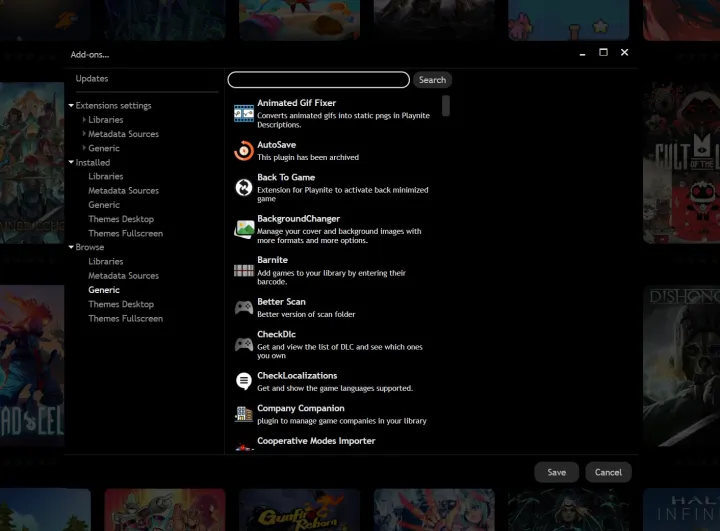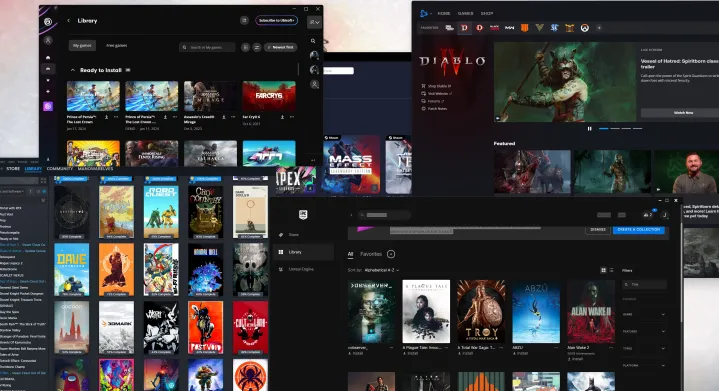There are far too many launchers for PC gaming. Even with various failed attempted from game publishers, such as the Bethesda launcher, we have more storefronts, libraries, and third-party apps than ever on PC, all of them gunning to capture just a little bit of the magic Valve bottled up with Steam back in the early 2000s.
I’m sick of them, and I’m sure you are too. You can’t uninstall all of your launchers if you want to play games you have on various storefronts, but you can unify your library in a single spot and minimize how much the various different launchers on PC pester you. Here’s how I did it.
My preferred method: Steam

There are a few different ways to get your PC games in one spot, but I prefer Steam. The majority of my games are already on Steam, it’s an app that every PC gamer has installed already, and it comes with a dense ecosystem of tools that make organizing your games easy.
You can add any external game or application to Steam easily. From your library, select Add a game in the bottom left corner, then choose Add a non-Steam game. You’ll see a list of applications installed on the hard drive Steam is installed on. You can either choose your game from here, or you can select Browse to find the executable.
Depending on the game, you want to find the actual game executable. You’ll often find a launcher, as well, and for some games, all you need to do is add the direct executable instead of the launcher.
If you’ve used Steam for a little while, you probably already know how to do this, but there’s a little cleanup we need to do.

First, the executable for a game you want to play might not be the same name as the game itself. For example, I own Stranger of Paradise: Final Fantasy Origin on the Epic Games Store, but the game’s executable is “SOPFFO.exe.”
That doesn’t look great in your library. Right-click on the game, select Properties, and you can rename the non-Steam app to anything you want.

That covers most games but not all of them. In particular, you may not be able to add all of your games from the Xbox app or Microsoft Store. Some of these games are UWP apps — they aren’t standard executables.
For those, you’ll need to download the UWPHook tool. This will add your UWP apps to Steam.

Do that for all of the games you have elsewhere — assuming they’re already installed, more on that soon — and you’ll be left with a bunch of gray tiles with a bland title across them. The next step is to get them looking like part of your library.
First, head over to SteamGridDB and download the SGDBoop tool. This is a database of both official and non-official artwork for games, and SGDBoop is an application that can automatically apply assets to your games.

I’ve written about how I overhauled my Steam library with SGDBoop, but it works with non-Steam games, too. Steam will automatically pull in the icon of the executable when you add the game to your library. There are four other elements you need to add manually: two grid images, a hero image, and a logo.
The two grid images are for the game as it shows up in your library and when it’s your most recently played title, the hero image is a background when you select the game, and the logo replaces Steam’s default text over the hero image.

Steam likes to bury your non-Steam games, so there’s one final step. Using the left menu, open the filters and select the Installed locally box. Then, choose Save as a Dynamic Collection. Using one of your shelves in Steam, select that dynamic collection, sort it however you wish, and you’ll see your non-Steam games alongside your Steam games.
That’s non-Steam games sorted, but what about games you bought on Steam? There are a ton of titles on Steam that come alongside a separate launcher, and in a lot of cases, you can bypass that launcher entirely. For example, Cyberpunk 2077 uses the Red Launcher, while Baldur’s Gate 3 uses its own launcher from Larian Studios.

Using Cyberpunk 2077 as an example, all you need to do is point Steam toward the correct executable. In a lot of cases, Steam is launching a separate executable that brings up a launcher, and then that launcher brings up the game’s executable. Find the Cyberpunk 2077 installation, follow Bin > x64 >Cyberpunk2077.exe. Right-click on the executable and choose Copy as path.
Back in Steam, right-click the game and choose Properties. Under the General tab, find the Launch options and paste the path you copied. It should paste with quotation marks, but if it doesn’t, add them in. At the end of the path, after the quotation mark, add a space and then %command%. You’re basically telling Steam that you want to launch this executable when you click on the game.
This works for any game that has a separate executable file for the launcher and the game itself. A lot of games have specific commands that skip the launcher — in Cyberpunk 2077, you can use –launcher-skip in the launch options, for example — but this should work even for games that don’t have that command. You’ll have to do a bit of digging to find the right file, so make sure to keep the PCGamingWiki handy for any special launch commands or file paths if you’re struggling with a particular game. Unfortunately, this process won’t work for things like Ubisoft Connect and the EA App. They’ll launch regardless.
There are two major downsides to this approach. First, it’s a very manual process. You have to add games individually, set their art, and dredge up commands to skip launchers. In addition, Steam doesn’t provide a way to see your uninstalled games. You can see games that are uninstalled on Steam, but not non-Steam games.
The alternative: Playnite or GOG Galaxy

If you’re less concerned about customizability and just want all of your games in one spot, you should use either Playnite or GOG Galaxy. Out of the two, I prefer Playnite because it’s open-source and features a variety of add-ons. That includes plug-ins for the major storefronts on PC. Here’s a full list:
- Steam
- Epic Games Store
- Amazon Games
- Ubisoft Connect
- EA App
- Battle.net
- GOG
- itch.io
- Humble App
- Xbox app
These add-ons not only import your installed and uninstalled games, they also keep you signed in. The app will still open, but you’ll be able to launch, uninstall, and install games in your library directly from Playnite. Out of the box, Playnite supports just about any game you can throw at it, and it includes IGDB (Internet Game Database) integration, automatically filling in your art and metadata details.
You can go further, though. As mentioned, Playnite is open-source and there are a slew of different add-ons and themes for the app. There’s an add-on that hides duplicates if you have a game across multiple storefronts, for example, and another that can check for free games on the Epic Games Store. My favorite by far is How Long to Beat integration, which shows you how long a game is, and SuccessStory, which integrates achievements into the app.

There’s so much Playnite is capable of, it’s a little overwhelming. From every option to organize your library to custom scripts you can run before, during, and after a game, you can really dig deep and build your library the way you want. I prefer the Steam method, but if you don’t mind getting your hands dirty, Playnite is undoubtedly more powerful.
GOG Galaxy is a bit different. It’s a launcher for games purchased through GOG, but it also supports community integrations for the Epic Games Store, EA App, Steam, Xbox, and Ubisoft Connect. You can install and uninstall your games, track playtime and achievements, and customize all of your metadata.

It’s definitely weaker than Playnite, however. You don’t have any options to skip launchers, there isn’t any way to add games outside of the small list of integrations, and there aren’t any plug-ins to customize your look. GOG Galaxy is a good option if all you care about is getting all of your games in one spot and don’t want to fuss around much.
Compared to using Steam, both of these apps definitely don’t look as nice. Playnite gives you a lot of customization options, and GOG Galaxy is easy to set up, but Steam has all of the tools you need to add non-Steam apps and bypass as many launchers as possible.
Never perfect

There’s no way to completely kill launchers on PC, but with a bit of work, you can get your library in one spot and disable a good chunk of the launchers you have to get through. You still need to install half a dozen storefronts, but at the very least you won’t have to click through endless pop-ups while trying to play your games.
Outside of making your games a little more organized, going through this process can boost your performance. We’ve seen in the past launchers like the 2K Launcher that can actually impact performance in games.
Services Marketplace – Listings, Bookings & Reviews
